Managerial Accounting Report: Arsenal FC's Operating Expenses Analysis
VerifiedAdded on 2023/04/20
|10
|1696
|382
Report
AI Summary
This report delves into the managerial accounting practices of football clubs, using Arsenal FC as a case study. It examines the operating expenses, including staff costs, player registrations, and depreciation, and how these are impacted by the club's decision to build a new stadium. The report analyzes the financial statements of Arsenal FC, comparing data from 2016 and 2017, and projects the extended operating expenses associated with increasing stadium capacity. It explores the implications of stadium development on the cost of revenue and highlights the importance of stadiums for football clubs' commercial strategies. The report includes tables and figures illustrating the financial data and provides insights into how stadium improvements can lead to increased revenue and profit. The analysis covers various aspects of financial performance, including operating profit, and discusses the relationship between operating expenses and the cost of revenue within the context of stadium expansion.
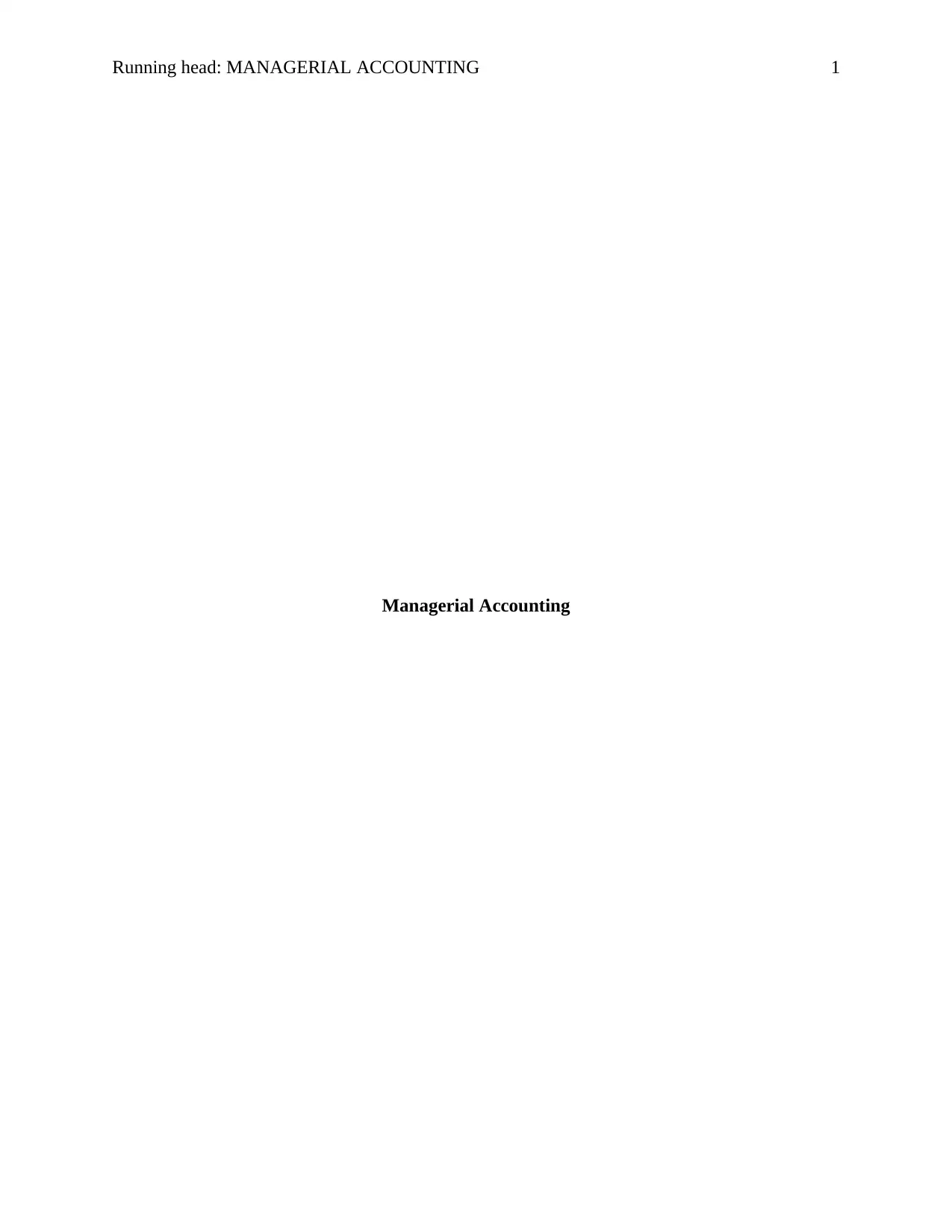
Running head: MANAGERIAL ACCOUNTING 1
Managerial Accounting
Managerial Accounting
Paraphrase This Document
Need a fresh take? Get an instant paraphrase of this document with our AI Paraphraser
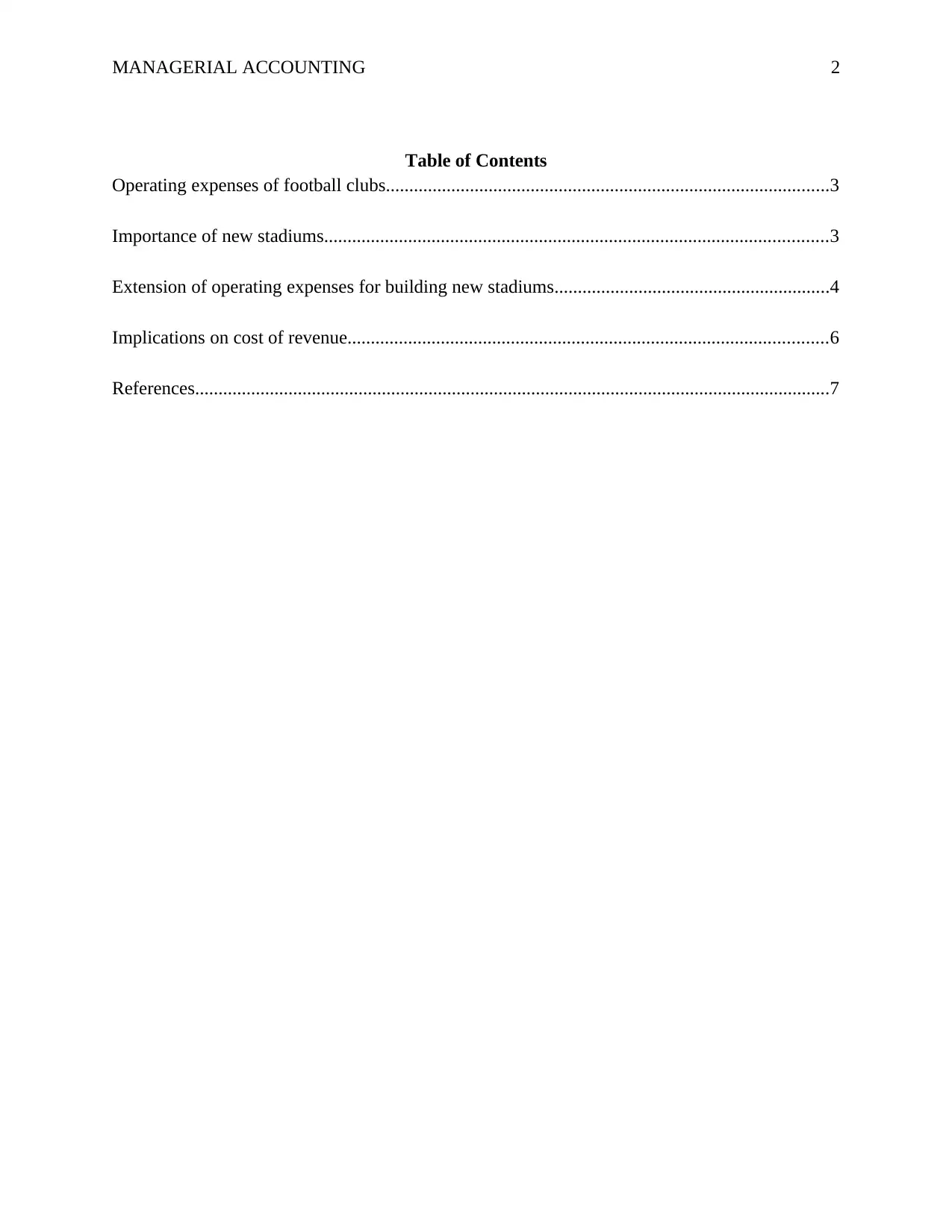
MANAGERIAL ACCOUNTING 2
Table of Contents
Operating expenses of football clubs...............................................................................................3
Importance of new stadiums............................................................................................................3
Extension of operating expenses for building new stadiums...........................................................4
Implications on cost of revenue.......................................................................................................6
References........................................................................................................................................7
Table of Contents
Operating expenses of football clubs...............................................................................................3
Importance of new stadiums............................................................................................................3
Extension of operating expenses for building new stadiums...........................................................4
Implications on cost of revenue.......................................................................................................6
References........................................................................................................................................7
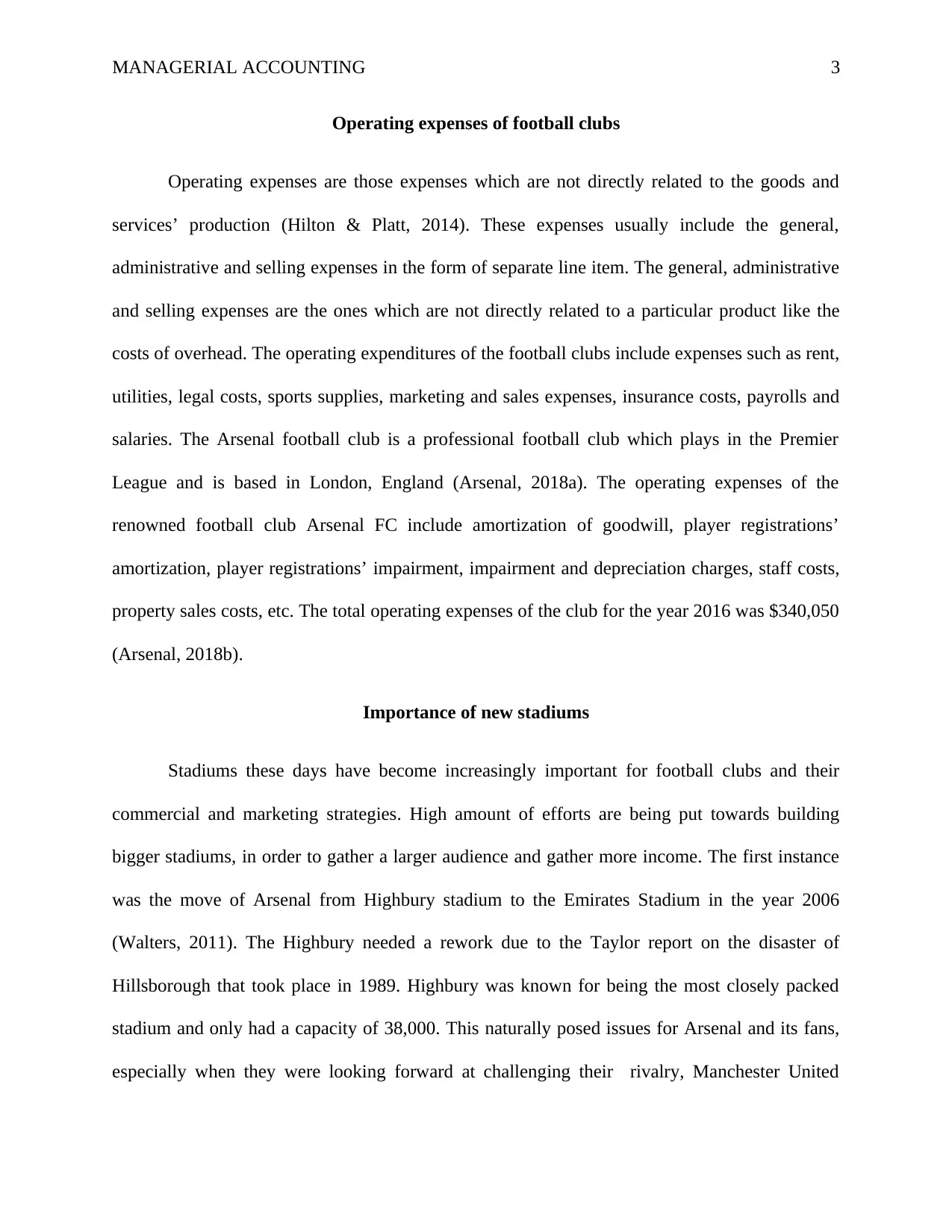
MANAGERIAL ACCOUNTING 3
Operating expenses of football clubs
Operating expenses are those expenses which are not directly related to the goods and
services’ production (Hilton & Platt, 2014). These expenses usually include the general,
administrative and selling expenses in the form of separate line item. The general, administrative
and selling expenses are the ones which are not directly related to a particular product like the
costs of overhead. The operating expenditures of the football clubs include expenses such as rent,
utilities, legal costs, sports supplies, marketing and sales expenses, insurance costs, payrolls and
salaries. The Arsenal football club is a professional football club which plays in the Premier
League and is based in London, England (Arsenal, 2018a). The operating expenses of the
renowned football club Arsenal FC include amortization of goodwill, player registrations’
amortization, player registrations’ impairment, impairment and depreciation charges, staff costs,
property sales costs, etc. The total operating expenses of the club for the year 2016 was $340,050
(Arsenal, 2018b).
Importance of new stadiums
Stadiums these days have become increasingly important for football clubs and their
commercial and marketing strategies. High amount of efforts are being put towards building
bigger stadiums, in order to gather a larger audience and gather more income. The first instance
was the move of Arsenal from Highbury stadium to the Emirates Stadium in the year 2006
(Walters, 2011). The Highbury needed a rework due to the Taylor report on the disaster of
Hillsborough that took place in 1989. Highbury was known for being the most closely packed
stadium and only had a capacity of 38,000. This naturally posed issues for Arsenal and its fans,
especially when they were looking forward at challenging their rivalry, Manchester United
Operating expenses of football clubs
Operating expenses are those expenses which are not directly related to the goods and
services’ production (Hilton & Platt, 2014). These expenses usually include the general,
administrative and selling expenses in the form of separate line item. The general, administrative
and selling expenses are the ones which are not directly related to a particular product like the
costs of overhead. The operating expenditures of the football clubs include expenses such as rent,
utilities, legal costs, sports supplies, marketing and sales expenses, insurance costs, payrolls and
salaries. The Arsenal football club is a professional football club which plays in the Premier
League and is based in London, England (Arsenal, 2018a). The operating expenses of the
renowned football club Arsenal FC include amortization of goodwill, player registrations’
amortization, player registrations’ impairment, impairment and depreciation charges, staff costs,
property sales costs, etc. The total operating expenses of the club for the year 2016 was $340,050
(Arsenal, 2018b).
Importance of new stadiums
Stadiums these days have become increasingly important for football clubs and their
commercial and marketing strategies. High amount of efforts are being put towards building
bigger stadiums, in order to gather a larger audience and gather more income. The first instance
was the move of Arsenal from Highbury stadium to the Emirates Stadium in the year 2006
(Walters, 2011). The Highbury needed a rework due to the Taylor report on the disaster of
Hillsborough that took place in 1989. Highbury was known for being the most closely packed
stadium and only had a capacity of 38,000. This naturally posed issues for Arsenal and its fans,
especially when they were looking forward at challenging their rivalry, Manchester United
⊘ This is a preview!⊘
Do you want full access?
Subscribe today to unlock all pages.

Trusted by 1+ million students worldwide
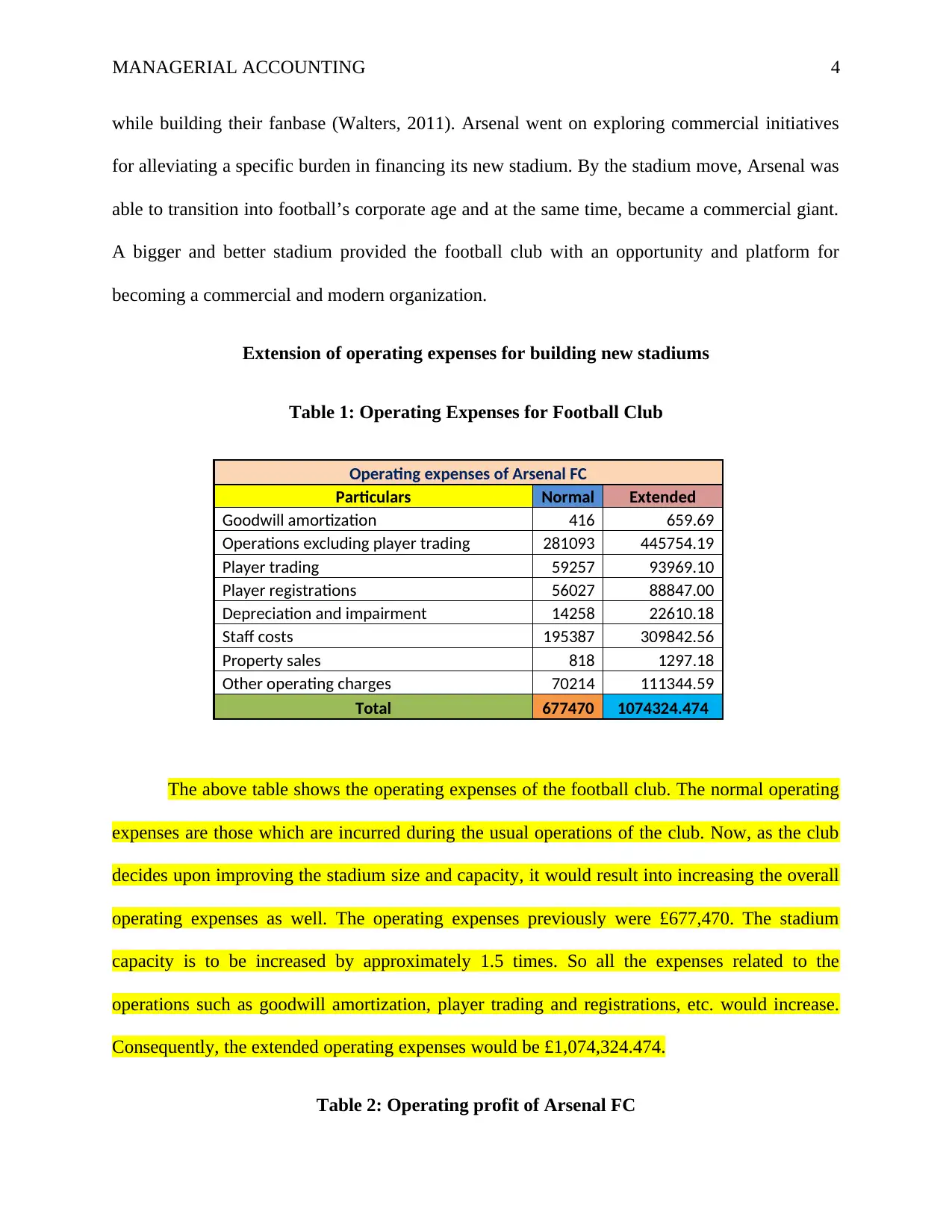
MANAGERIAL ACCOUNTING 4
while building their fanbase (Walters, 2011). Arsenal went on exploring commercial initiatives
for alleviating a specific burden in financing its new stadium. By the stadium move, Arsenal was
able to transition into football’s corporate age and at the same time, became a commercial giant.
A bigger and better stadium provided the football club with an opportunity and platform for
becoming a commercial and modern organization.
Extension of operating expenses for building new stadiums
Table 1: Operating Expenses for Football Club
Operating expenses of Arsenal FC
Particulars Normal Extended
Goodwill amortization 416 659.69
Operations excluding player trading 281093 445754.19
Player trading 59257 93969.10
Player registrations 56027 88847.00
Depreciation and impairment 14258 22610.18
Staff costs 195387 309842.56
Property sales 818 1297.18
Other operating charges 70214 111344.59
Total 677470 1074324.474
The above table shows the operating expenses of the football club. The normal operating
expenses are those which are incurred during the usual operations of the club. Now, as the club
decides upon improving the stadium size and capacity, it would result into increasing the overall
operating expenses as well. The operating expenses previously were £677,470. The stadium
capacity is to be increased by approximately 1.5 times. So all the expenses related to the
operations such as goodwill amortization, player trading and registrations, etc. would increase.
Consequently, the extended operating expenses would be £1,074,324.474.
Table 2: Operating profit of Arsenal FC
while building their fanbase (Walters, 2011). Arsenal went on exploring commercial initiatives
for alleviating a specific burden in financing its new stadium. By the stadium move, Arsenal was
able to transition into football’s corporate age and at the same time, became a commercial giant.
A bigger and better stadium provided the football club with an opportunity and platform for
becoming a commercial and modern organization.
Extension of operating expenses for building new stadiums
Table 1: Operating Expenses for Football Club
Operating expenses of Arsenal FC
Particulars Normal Extended
Goodwill amortization 416 659.69
Operations excluding player trading 281093 445754.19
Player trading 59257 93969.10
Player registrations 56027 88847.00
Depreciation and impairment 14258 22610.18
Staff costs 195387 309842.56
Property sales 818 1297.18
Other operating charges 70214 111344.59
Total 677470 1074324.474
The above table shows the operating expenses of the football club. The normal operating
expenses are those which are incurred during the usual operations of the club. Now, as the club
decides upon improving the stadium size and capacity, it would result into increasing the overall
operating expenses as well. The operating expenses previously were £677,470. The stadium
capacity is to be increased by approximately 1.5 times. So all the expenses related to the
operations such as goodwill amortization, player trading and registrations, etc. would increase.
Consequently, the extended operating expenses would be £1,074,324.474.
Table 2: Operating profit of Arsenal FC
Paraphrase This Document
Need a fresh take? Get an instant paraphrase of this document with our AI Paraphraser
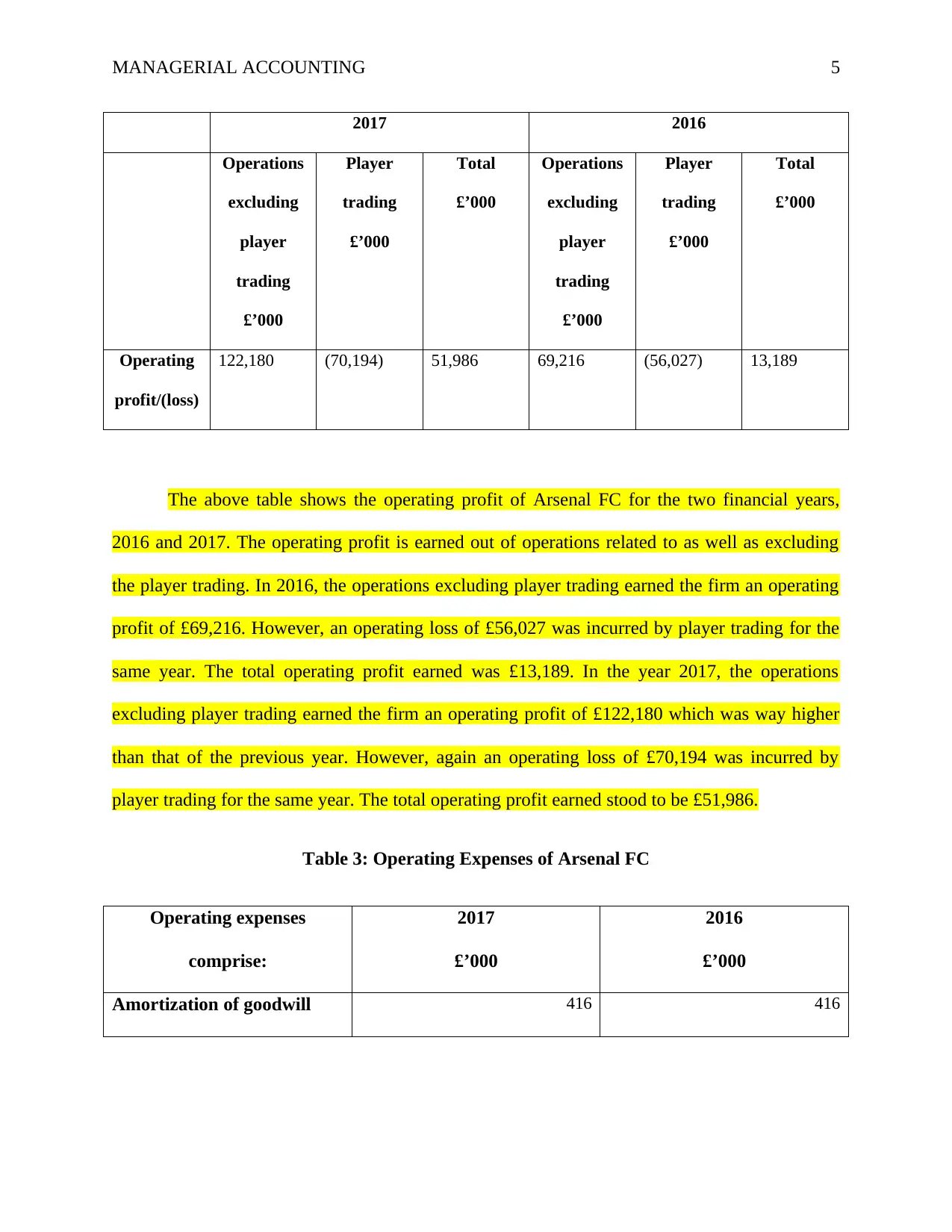
MANAGERIAL ACCOUNTING 5
2017 2016
Operations
excluding
player
trading
£’000
Player
trading
£’000
Total
£’000
Operations
excluding
player
trading
£’000
Player
trading
£’000
Total
£’000
Operating
profit/(loss)
122,180 (70,194) 51,986 69,216 (56,027) 13,189
The above table shows the operating profit of Arsenal FC for the two financial years,
2016 and 2017. The operating profit is earned out of operations related to as well as excluding
the player trading. In 2016, the operations excluding player trading earned the firm an operating
profit of £69,216. However, an operating loss of £56,027 was incurred by player trading for the
same year. The total operating profit earned was £13,189. In the year 2017, the operations
excluding player trading earned the firm an operating profit of £122,180 which was way higher
than that of the previous year. However, again an operating loss of £70,194 was incurred by
player trading for the same year. The total operating profit earned stood to be £51,986.
Table 3: Operating Expenses of Arsenal FC
Operating expenses
comprise:
2017
£’000
2016
£’000
Amortization of goodwill 416 416
2017 2016
Operations
excluding
player
trading
£’000
Player
trading
£’000
Total
£’000
Operations
excluding
player
trading
£’000
Player
trading
£’000
Total
£’000
Operating
profit/(loss)
122,180 (70,194) 51,986 69,216 (56,027) 13,189
The above table shows the operating profit of Arsenal FC for the two financial years,
2016 and 2017. The operating profit is earned out of operations related to as well as excluding
the player trading. In 2016, the operations excluding player trading earned the firm an operating
profit of £69,216. However, an operating loss of £56,027 was incurred by player trading for the
same year. The total operating profit earned was £13,189. In the year 2017, the operations
excluding player trading earned the firm an operating profit of £122,180 which was way higher
than that of the previous year. However, again an operating loss of £70,194 was incurred by
player trading for the same year. The total operating profit earned stood to be £51,986.
Table 3: Operating Expenses of Arsenal FC
Operating expenses
comprise:
2017
£’000
2016
£’000
Amortization of goodwill 416 416
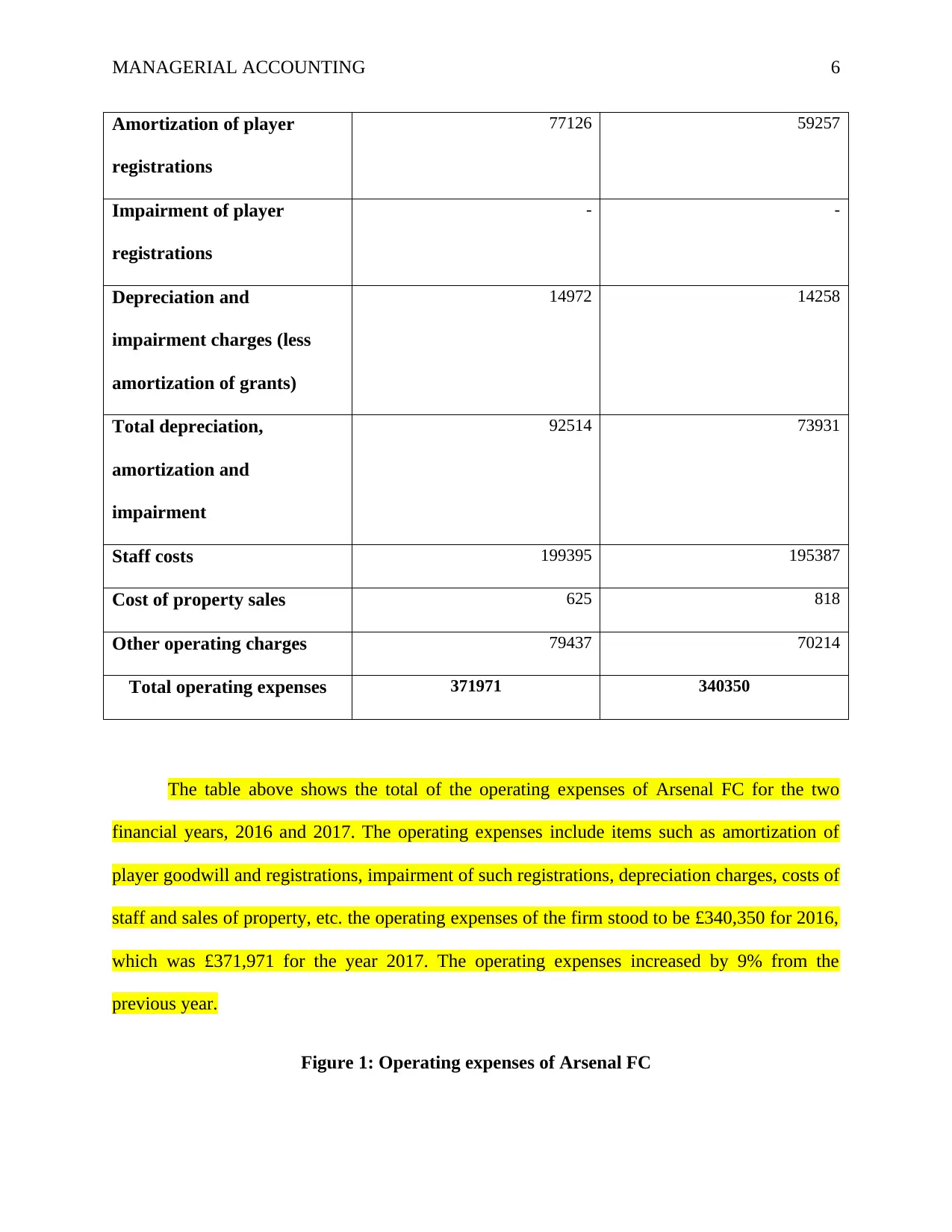
MANAGERIAL ACCOUNTING 6
Amortization of player
registrations
77126 59257
Impairment of player
registrations
- -
Depreciation and
impairment charges (less
amortization of grants)
14972 14258
Total depreciation,
amortization and
impairment
92514 73931
Staff costs 199395 195387
Cost of property sales 625 818
Other operating charges 79437 70214
Total operating expenses 371971 340350
The table above shows the total of the operating expenses of Arsenal FC for the two
financial years, 2016 and 2017. The operating expenses include items such as amortization of
player goodwill and registrations, impairment of such registrations, depreciation charges, costs of
staff and sales of property, etc. the operating expenses of the firm stood to be £340,350 for 2016,
which was £371,971 for the year 2017. The operating expenses increased by 9% from the
previous year.
Figure 1: Operating expenses of Arsenal FC
Amortization of player
registrations
77126 59257
Impairment of player
registrations
- -
Depreciation and
impairment charges (less
amortization of grants)
14972 14258
Total depreciation,
amortization and
impairment
92514 73931
Staff costs 199395 195387
Cost of property sales 625 818
Other operating charges 79437 70214
Total operating expenses 371971 340350
The table above shows the total of the operating expenses of Arsenal FC for the two
financial years, 2016 and 2017. The operating expenses include items such as amortization of
player goodwill and registrations, impairment of such registrations, depreciation charges, costs of
staff and sales of property, etc. the operating expenses of the firm stood to be £340,350 for 2016,
which was £371,971 for the year 2017. The operating expenses increased by 9% from the
previous year.
Figure 1: Operating expenses of Arsenal FC
⊘ This is a preview!⊘
Do you want full access?
Subscribe today to unlock all pages.

Trusted by 1+ million students worldwide
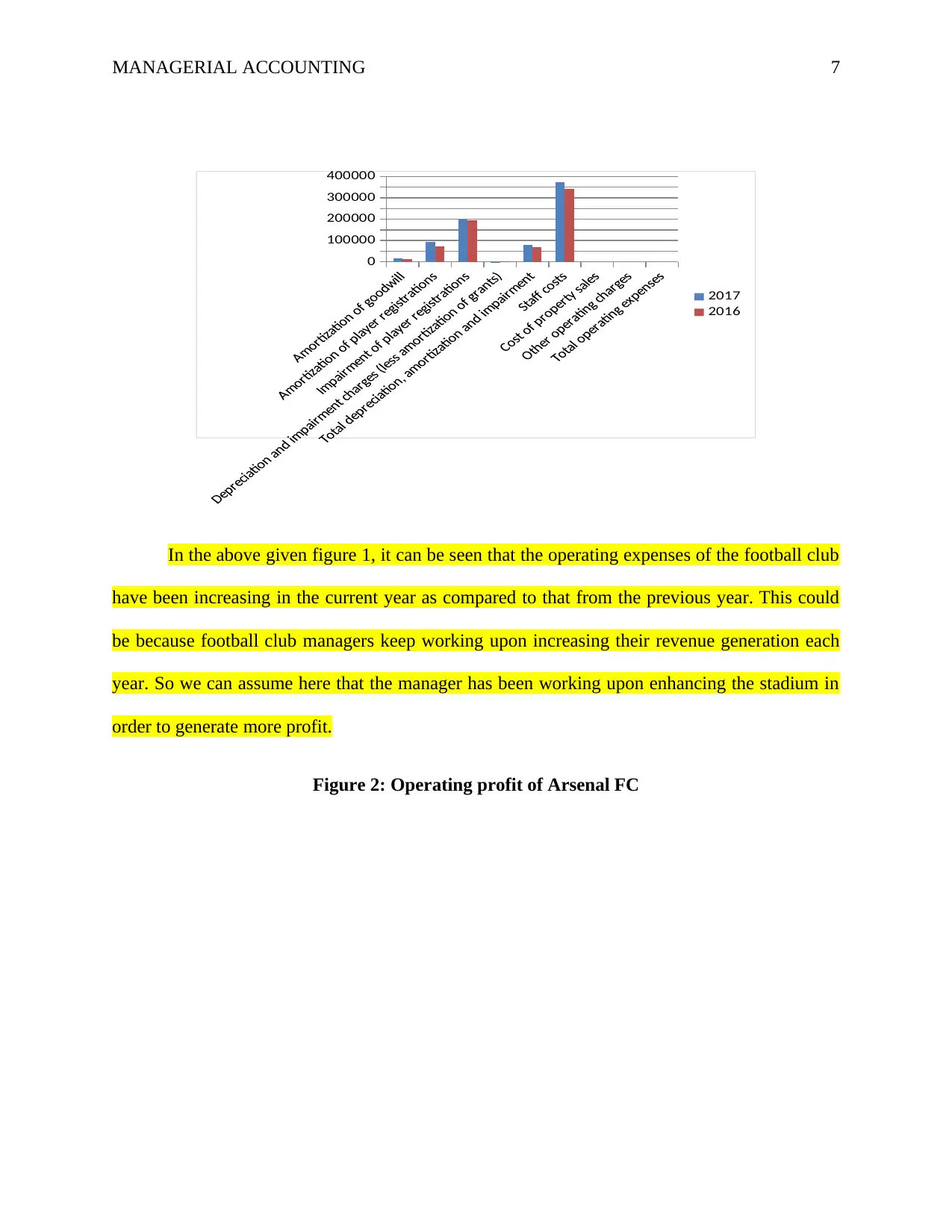
MANAGERIAL ACCOUNTING 7
0
100000
200000
300000
400000
2017
2016
In the above given figure 1, it can be seen that the operating expenses of the football club
have been increasing in the current year as compared to that from the previous year. This could
be because football club managers keep working upon increasing their revenue generation each
year. So we can assume here that the manager has been working upon enhancing the stadium in
order to generate more profit.
Figure 2: Operating profit of Arsenal FC
0
100000
200000
300000
400000
2017
2016
In the above given figure 1, it can be seen that the operating expenses of the football club
have been increasing in the current year as compared to that from the previous year. This could
be because football club managers keep working upon increasing their revenue generation each
year. So we can assume here that the manager has been working upon enhancing the stadium in
order to generate more profit.
Figure 2: Operating profit of Arsenal FC
Paraphrase This Document
Need a fresh take? Get an instant paraphrase of this document with our AI Paraphraser
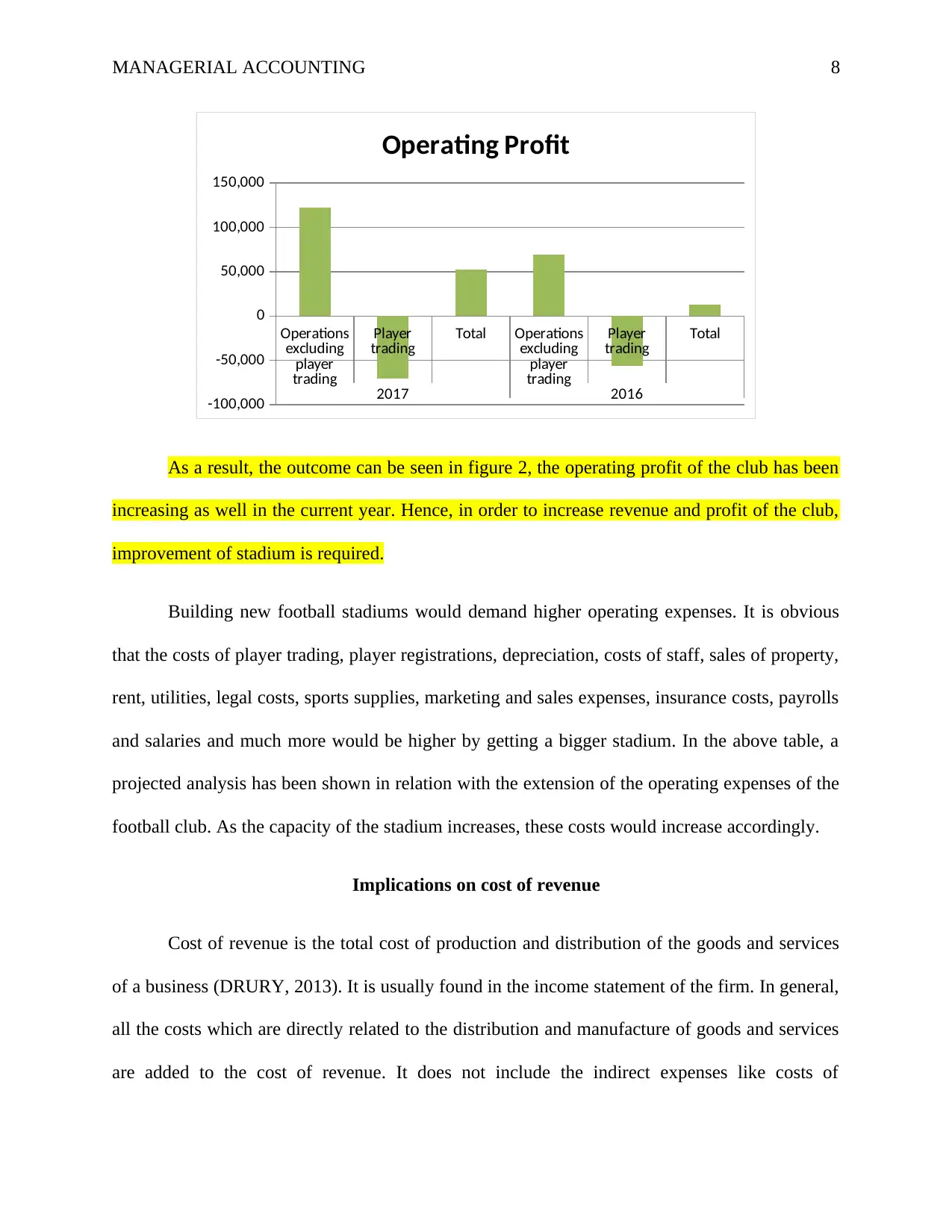
MANAGERIAL ACCOUNTING 8
Operations
excluding
player
trading
Player
trading Total Operations
excluding
player
trading
Player
trading Total
2017 2016
-100,000
-50,000
0
50,000
100,000
150,000
Operating Profit
As a result, the outcome can be seen in figure 2, the operating profit of the club has been
increasing as well in the current year. Hence, in order to increase revenue and profit of the club,
improvement of stadium is required.
Building new football stadiums would demand higher operating expenses. It is obvious
that the costs of player trading, player registrations, depreciation, costs of staff, sales of property,
rent, utilities, legal costs, sports supplies, marketing and sales expenses, insurance costs, payrolls
and salaries and much more would be higher by getting a bigger stadium. In the above table, a
projected analysis has been shown in relation with the extension of the operating expenses of the
football club. As the capacity of the stadium increases, these costs would increase accordingly.
Implications on cost of revenue
Cost of revenue is the total cost of production and distribution of the goods and services
of a business (DRURY, 2013). It is usually found in the income statement of the firm. In general,
all the costs which are directly related to the distribution and manufacture of goods and services
are added to the cost of revenue. It does not include the indirect expenses like costs of
Operations
excluding
player
trading
Player
trading Total Operations
excluding
player
trading
Player
trading Total
2017 2016
-100,000
-50,000
0
50,000
100,000
150,000
Operating Profit
As a result, the outcome can be seen in figure 2, the operating profit of the club has been
increasing as well in the current year. Hence, in order to increase revenue and profit of the club,
improvement of stadium is required.
Building new football stadiums would demand higher operating expenses. It is obvious
that the costs of player trading, player registrations, depreciation, costs of staff, sales of property,
rent, utilities, legal costs, sports supplies, marketing and sales expenses, insurance costs, payrolls
and salaries and much more would be higher by getting a bigger stadium. In the above table, a
projected analysis has been shown in relation with the extension of the operating expenses of the
football club. As the capacity of the stadium increases, these costs would increase accordingly.
Implications on cost of revenue
Cost of revenue is the total cost of production and distribution of the goods and services
of a business (DRURY, 2013). It is usually found in the income statement of the firm. In general,
all the costs which are directly related to the distribution and manufacture of goods and services
are added to the cost of revenue. It does not include the indirect expenses like costs of
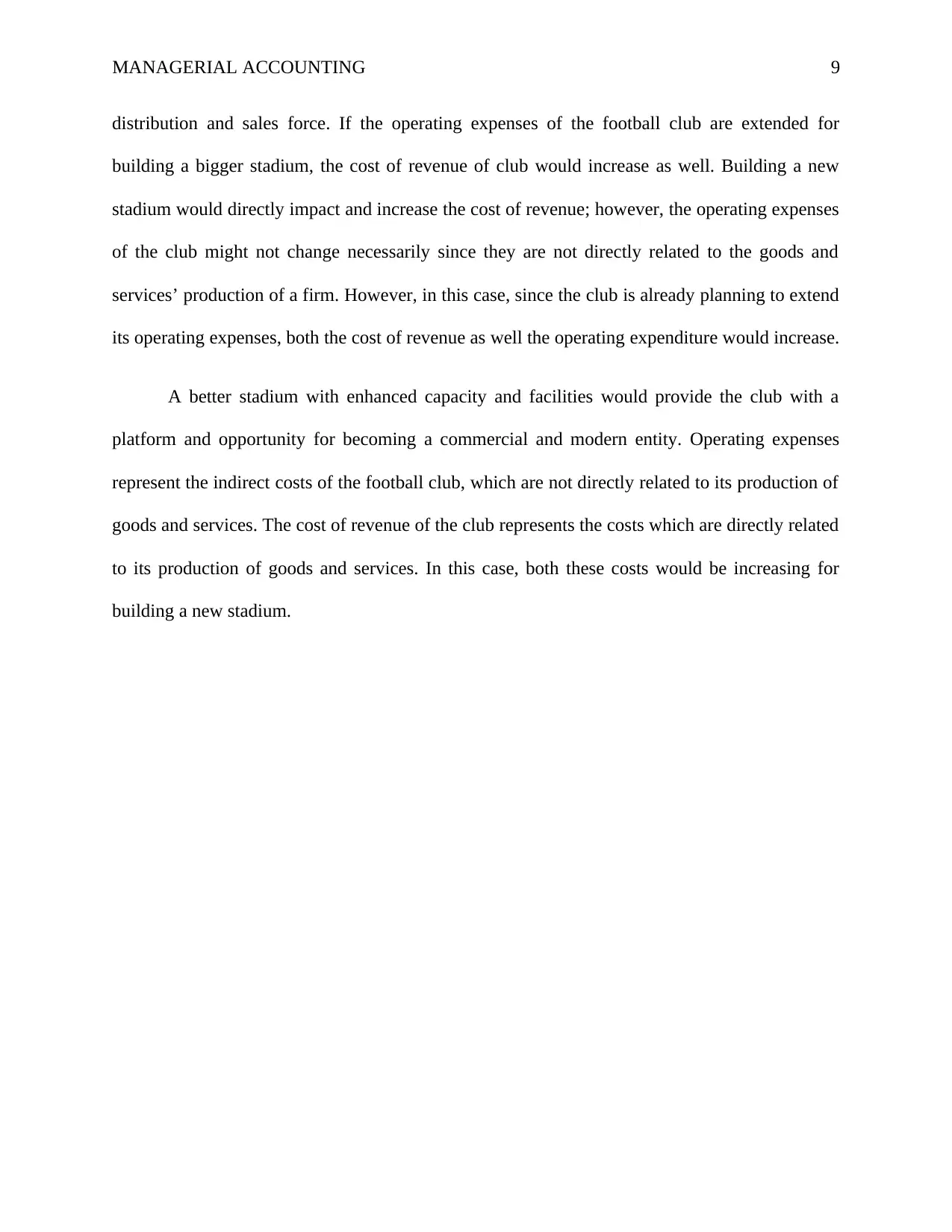
MANAGERIAL ACCOUNTING 9
distribution and sales force. If the operating expenses of the football club are extended for
building a bigger stadium, the cost of revenue of club would increase as well. Building a new
stadium would directly impact and increase the cost of revenue; however, the operating expenses
of the club might not change necessarily since they are not directly related to the goods and
services’ production of a firm. However, in this case, since the club is already planning to extend
its operating expenses, both the cost of revenue as well the operating expenditure would increase.
A better stadium with enhanced capacity and facilities would provide the club with a
platform and opportunity for becoming a commercial and modern entity. Operating expenses
represent the indirect costs of the football club, which are not directly related to its production of
goods and services. The cost of revenue of the club represents the costs which are directly related
to its production of goods and services. In this case, both these costs would be increasing for
building a new stadium.
distribution and sales force. If the operating expenses of the football club are extended for
building a bigger stadium, the cost of revenue of club would increase as well. Building a new
stadium would directly impact and increase the cost of revenue; however, the operating expenses
of the club might not change necessarily since they are not directly related to the goods and
services’ production of a firm. However, in this case, since the club is already planning to extend
its operating expenses, both the cost of revenue as well the operating expenditure would increase.
A better stadium with enhanced capacity and facilities would provide the club with a
platform and opportunity for becoming a commercial and modern entity. Operating expenses
represent the indirect costs of the football club, which are not directly related to its production of
goods and services. The cost of revenue of the club represents the costs which are directly related
to its production of goods and services. In this case, both these costs would be increasing for
building a new stadium.
⊘ This is a preview!⊘
Do you want full access?
Subscribe today to unlock all pages.

Trusted by 1+ million students worldwide
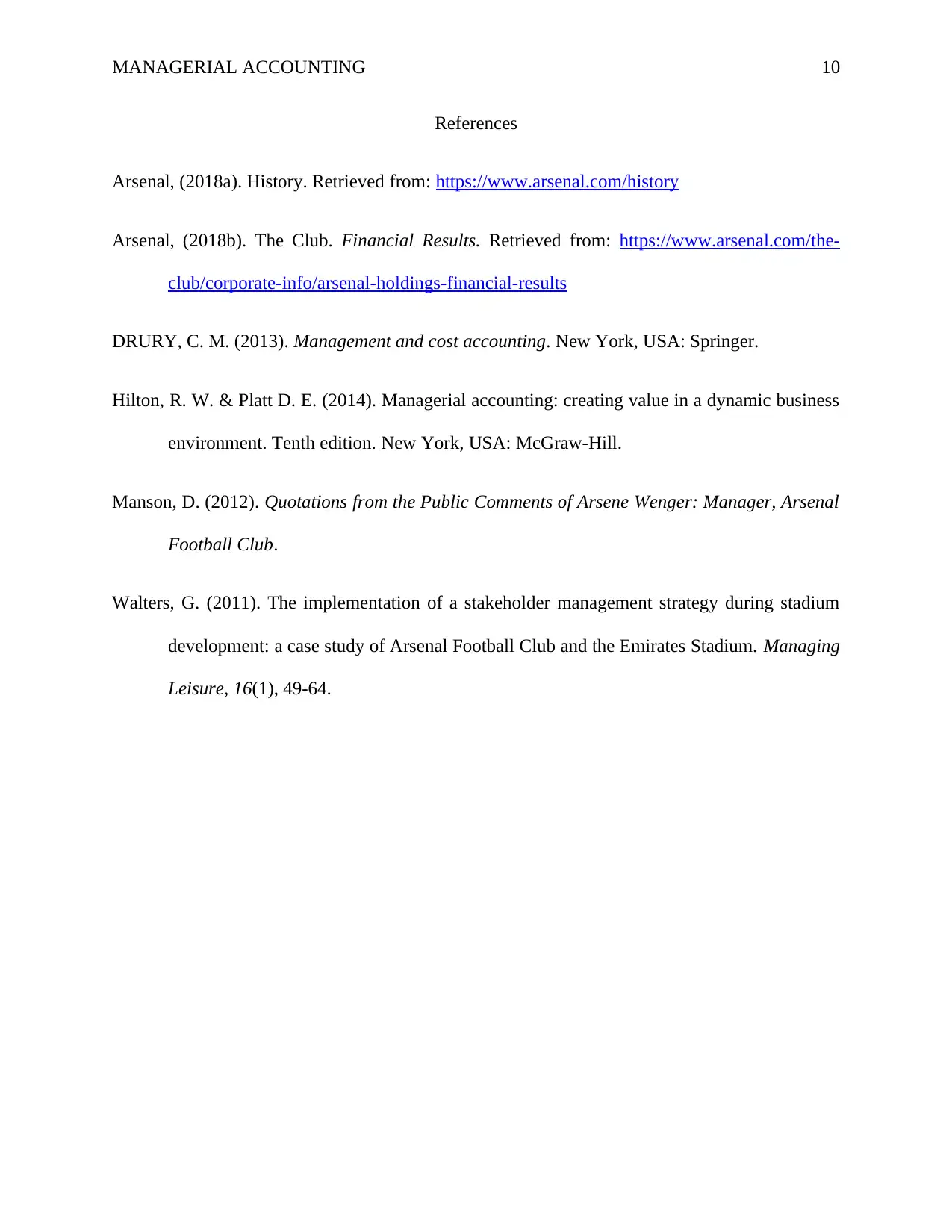
MANAGERIAL ACCOUNTING 10
References
Arsenal, (2018a). History. Retrieved from: https://www.arsenal.com/history
Arsenal, (2018b). The Club. Financial Results. Retrieved from: https://www.arsenal.com/the-
club/corporate-info/arsenal-holdings-financial-results
DRURY, C. M. (2013). Management and cost accounting. New York, USA: Springer.
Hilton, R. W. & Platt D. E. (2014). Managerial accounting: creating value in a dynamic business
environment. Tenth edition. New York, USA: McGraw-Hill.
Manson, D. (2012). Quotations from the Public Comments of Arsene Wenger: Manager, Arsenal
Football Club.
Walters, G. (2011). The implementation of a stakeholder management strategy during stadium
development: a case study of Arsenal Football Club and the Emirates Stadium. Managing
Leisure, 16(1), 49-64.
References
Arsenal, (2018a). History. Retrieved from: https://www.arsenal.com/history
Arsenal, (2018b). The Club. Financial Results. Retrieved from: https://www.arsenal.com/the-
club/corporate-info/arsenal-holdings-financial-results
DRURY, C. M. (2013). Management and cost accounting. New York, USA: Springer.
Hilton, R. W. & Platt D. E. (2014). Managerial accounting: creating value in a dynamic business
environment. Tenth edition. New York, USA: McGraw-Hill.
Manson, D. (2012). Quotations from the Public Comments of Arsene Wenger: Manager, Arsenal
Football Club.
Walters, G. (2011). The implementation of a stakeholder management strategy during stadium
development: a case study of Arsenal Football Club and the Emirates Stadium. Managing
Leisure, 16(1), 49-64.
1 out of 10
Your All-in-One AI-Powered Toolkit for Academic Success.
+13062052269
info@desklib.com
Available 24*7 on WhatsApp / Email
![[object Object]](/_next/static/media/star-bottom.7253800d.svg)
Unlock your academic potential
Copyright © 2020–2025 A2Z Services. All Rights Reserved. Developed and managed by ZUCOL.